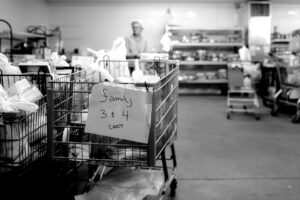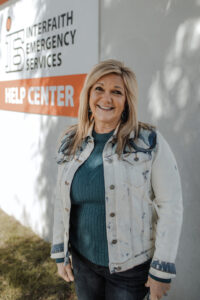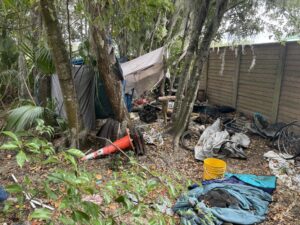
Everyday dozens of people walk into Interfaith Emergency Service’s new Engagement Center looking for help. They are Ocala’s homeless. Some need a shower. Some need clothing or shoes. Some need food. Some need medication. Some need an ID. On the day we visited, free HIV tests were being offered.
Regardless of their needs, Interfaith works to meet those needs – with something extra … hopefully.
“We don’t want them to just come in here for a handout,” said Karla Greenway, Interfaith’s longtime CEO. “We want them to find purpose.”
That is the challenge for the organizations that provide services to homeless people in Ocala/Marion County. While the annual Point in Time Count of the homeless population conducted each January under the auspices of the U.S. Department of Housing and Urban Development, of HUD, tallied 378 officially homeless last year, those who work with the homeless agree the real number is higher, with some saying it is growing. The Point in Time Count, however, does not count people who are couch surfing with a friend or a relative or those living in motels.

“Every patch of woods in Ocala has a camp of homeless people living in it – every patch,” Greenway said. City homeless outreach officials estimate there are about 50 encampments throughout the city, typically ranging in size from one person up to nine people.
Moreover, she added, the number of homeless is growing, “but not in the way you may think.”
“We’re seeing more moms living in their cars with children because people are losing their home because of affordability, with rising rents, homeowners’ insurance and taxes also rising,” Greenway said. “I think if we knew how many people are being displaced because they can’t afford their rent, we’d be shocked.”
Tracking the homeless
Yet, Robin Ford, who heads the city’s Office of Homeless Prevention, said Ocala has plenty of organizations and agencies providing a breadth of services to homeless people, depending on their situation. And, she said, her staff of three outreach officers work diligently to track the homeless population on a daily basis.
“We track everything we do,” said Ford, a former Ocala Police Department major who was with the department for 31 years and has been in her current post since 2020. “Every time we interact with someone, they write a synopsis of what they did. We work really hard to keep up with them. … We see the same people a lot.”
Ford said her outreach officers – two ex-law enforcement officers and a veteran with mental health experience – ask each homeless person they engage a series of question. Do you live in a shelter? Are you a veteran? Have you been a victim of domestic violence? Do you use alcohol or drugs? Do you have mental health issues? Do you have a physical disability? How many adults are in your household?
The No. 1 goal is to try and get them in a shelter of some kind. The second goal is to determine if they qualify for some kind of assistance that they are eligible for but are not receiving – everything from veterans benefits and Social Security to mental health counseling and needed medication. Often, the homeless don’t know what benefits are available to them or they simply do not have the paperwork or ID necessary to sign up for those benefits.
“Getting them into a shelter is the key,” Ford said, adding that is where they can get help obtaining those benefits. “Sometimes its mental health. Sometimes its mental health medication. Sometimes it’s employment counseling and not just getting them a job.”
PTSD and more
Mental health is a big problem among the homeless. Depending on who you talk to, the percentage of people who are homeless and have mental health issues ranges from 75 percent to more than 90 percent.
Ned Giroux, a retired police officer who is now manager of Interfaith’s Engagement Center, said he sees hundreds of people each month at his facility and almost all of them are suffering from some sort of mental health disorder.
“A lot of them have PTSD (post-traumatic stress disorder) just from being homeless,” he said. And many, he added, “have just given up.”
“A good portion are just looking for safety,” Giroux said. “People who live on the streets – almost all of them – have been attacked or robbed, so there’s trauma there.”

Trust, or more specifically a lack of trust, is another issue those serving the homeless face, Giroux said, because too many times “they’ve been told they’d get help, and they didn’t get it.”
Once again, getting the homeless into some kind of shelter or housing is key to getting them help.
“The guy in the street is not the problem,” Ocala City Manager Pete Lee said. “He’s the symptom. Ninety percent of the people who are unsheltered want to go back in a shelter but are suffering from episodic conditions that become a mental health issue. It’s a very personalized, individualized approach that is effective.”
Ford, Greenway and Lee all agree there are a wide variety of services available in Ocala/Marion County to serve homeless people of any circumstance.
“There’s a lot of people in this town who work really, really hard to get the number of unsheltered people down,” Ford said. “But a lot of people don’t want to go into a shelter.”
Housing, just not enough
Here’s a look at some of the organizations that provide housing to the homeless and the different types of clients they serve.
• Traditional housing: Open Arms Village (men only), Project Hope (women and children only), Shepherd’s Lighthouse, Refuge of Hope, Break Barriers and the Salvation Army.
• Emergency shelters: Arnette House (children only), CASA Marion (domestic violence victims), Interfaith (women and children only) and the Salvation Army.
• Permanent supportive housing: Interfaith, VASH (veterans only) and Shepherd’s Lighthouse.
• Rapid rehousing for short- and medium-term housing: Saving Mercy and Volunteers of America (veterans).
• Other permanent housing: Ocala Housing Authority, Volunteers of America and Wear Gloves.
Despite all these options, those closest to the issue say more housing is needed, especially low-cost permanent housing.
“The number of homeless is going to get bigger, as the cost of housing is going to affect more and more middle-class households,” Greenway said.
Cheryl Martin is the director of Marion County Community Services. As such she is also the coordinator the Ocala/Marion County Continuum of Care. The Continuum of Care is a consortium of groups that assist the homeless that is required by HUD to qualify for and manage federal and state funding aimed at reducing homelessness.
Martin said a recent study by the Ocala/Marion County Public Policy Institute on homelessness found that our community has a higher rate of “chronically homeless” than the state as a whole.
Martin agreed with others that there are a lot of great programs aimed at the homeless here, but sometimes coordination between them is lacking. It is an issue the Continuum of Care is looking to address at a meeting on Feb. 11.
“The goal is to improve coordination,” she said.
She said there are two big concerns going into that meeting.
One, the homeless services sector does a poor job of letting the greater community know what they do.
“They are the worst at tooting their own horns,” Martin said. “You can’t raise money if people don’t know what you do.”
Two, the proximity to services is a problem in a sprawling county like Marion that is the size of some small states.
“The challenge we have is all the services are in the city,” Martin added. “So, people in outlying areas can’t access them if they want to.”
Martin said there is a chronic lack of apartments that cost $1,000 a month or less or houses that cost $100,000 or less. There is good news on the horizon, however, in terms of more housing options for the homeless. Saving Mercy is building a new facility on State Road 40 near Interstate 75 with 79 units. Wear Gloves, which helps ready-to-work homeless find jobs, is in the process of opening housing units for its clients. Open Arms is opening a new women’s shelter. And 99 low-income apartments known as Madison Oaks have been built on the old Pine Oaks golf course. She added that the Continuum of Care is working to acquire two apartment complexes to be turned into low-income housing.
But, Ford noted, there needs to be more subsidized housing, given that the average Social Security check is $993 a month.
It takes time
For all the challenges, Greenway said that in 2024 Interfaith saw a 95 percent success rate in getting its “members” the help they needed to get into housing and resolve their individual problems, whether they be mental health, medical or acquiring benefits they qualified for but were not receiving. She said more access to mental health counseling “has been a game changer” — although even more is needed.
“We need more options for people with mental illness,” Greenway said. “And that’s not just Ocala, that’s nationally.”
She said one aspect of some local homeless services that deters greater success is that many of the homeless need extended time to get their issues resolved. For example, she said, if Interfaith was limited to 30 days, as some shelter programs are, to get all the help a person needed, it would not have the success rate it has.
“If we had a timeline that you could only stay 30 days, we wouldn’t have the success we have,” she said. In some cases, she said, it takes three years to get a person disability payments for which they qualify.
Ford said one of the city’s feel-good programs is when they find a homeless person from somewhere else who is ready to go back home. The city buys them a bus ticket and sends them home. (Interestingly, there is no bus station in Ocala. They have to be driven to Gainesville to catch a bus.)
“I think it’s money well spent,” Ford said. “It’s good for the city and it’s also good for the client. Sometimes we send whole families to someplace they can thrive.
“Of course, we’re not going to send somebody somewhere else just to be homeless in another place, because we don’t want (other cities) to do that to us.”
Ford did have one warning for local residents – be wary of panhandlers. Because her staff talks to every person they run into that appears to be homeless, she said they engage all panhandlers standing at intersections.
“Eighty percent of them are not homeless,” she said. “That is their job. And some of them do pretty well. Some make $200 a day. Yet, seeing them gives you the impression there are a lot more homeless people than there are.”
Yet, there are more homeless people on the streets, in the woods and in the shelters than the community can accommodate. Yes, there are a lot of organizations doing a lot of things to help them. But as Greenway noted, the cost of housing is just driving more people from their homes.






